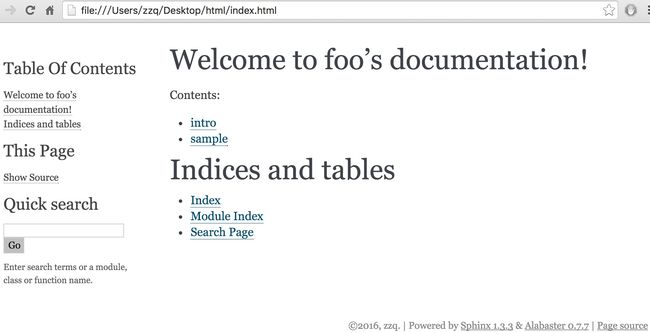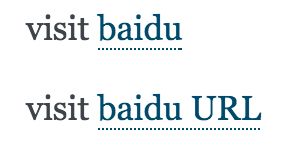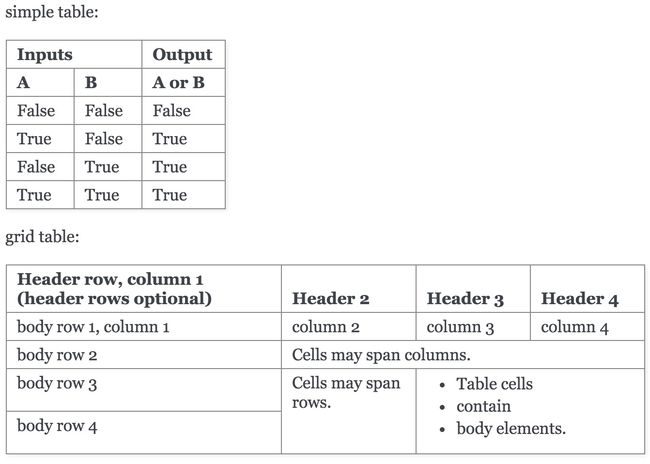【文档】使用Sphinx + reST编写文档
0 前言
写文档是开发人员日常工作中的一项重要内容,除了word之外,我更偏爱使用标记语言(Markup Language)。使用标记语言,可以利用简单、免费的文本编辑器(记事本,vim, emacs...)编写文档并设置格式,再生成html或pdf等格式,或者直接把编辑好的文件传到github或wiki上面 ,通过浏览器可以直接查看带有格式的文档。
目前标记语言主要有两种,Markdown和reStructuredText(简称reST)。该使用哪一种是一个见仁见智的选择,我在这里就不比较它们(包括其他标记语言)的优劣了,感兴趣的可以参考:
- 知乎:Org-mode、reST、 Markdown 各有什么优缺点?
- 维基百科(英文):Lightweight markup language
对我个人来说,一开始尝试了一段时间的Markdown,由于工具不好用以及支持的格式不多的原因,转而使用reST,再配合sphinx,感觉好极了。
很多开源项目的文档就是用sphinx+reST做的,比如最近我正关注的hyperscan:http://01org.github.io/hyperscan/dev-reference/。大家可以点进去看一下生成的效果,它用的样式是Alabaster 0.7.6。
本文以下内容以Ubuntu 14.04为例进行说明。
1 安装与环境配置
1.1 安装Sphinx
使用sphinx+reST编写文档,需要安装一些软件包
sudo apt-get install python-pip sudo pip install Sphinx
1.2 环境配置与html生成步骤
最简单的方法是建立工作目录后(这里是doc),在其中运行sphinx-quickstart。运行此命令后sphinx会问你一些问题,根据情况回答即可。在这里我建立了一个名为foo的Project,版本是1.0,作者名为zzq,将source与build目录放开,其他都选默认:
zzq@vmware:~/doc$ sphinx-quickstart Welcome to the Sphinx 1.3.3 quickstart utility. Please enter values for the following settings (just press Enter to accept a default value, if one is given in brackets). Enter the root path for documentation. > Root path for the documentation [.]: You have two options for placing the build directory for Sphinx output. Either, you use a directory "_build" within the root path, or you separate "source" and "build" directories within the root path. > Separate source and build directories (y/n) [n]: y Inside the root directory, two more directories will be created; "_templates" for custom HTML templates and "_static" for custom stylesheets and other static files. You can enter another prefix (such as ".") to replace the underscore. > Name prefix for templates and static dir [_]: The project name will occur in several places in the built documentation. > Project name: foo > Author name(s): zzq Sphinx has the notion of a "version" and a "release" for the software. Each version can have multiple releases. For example, for Python the version is something like 2.5 or 3.0, while the release is something like 2.5.1 or 3.0a1. If you don't need this dual structure, just set both to the same value. > Project version: 1.0 > Project release [1.0]: If the documents are to be written in a language other than English, you can select a language here by its language code. Sphinx will then translate text that it generates into that language. For a list of supported codes, see http://sphinx-doc.org/config.html#confval-language. > Project language [en]: The file name suffix for source files. Commonly, this is either ".txt" or ".rst". Only files with this suffix are considered documents. > Source file suffix [.rst]: One document is special in that it is considered the top node of the "contents tree", that is, it is the root of the hierarchical structure of the documents. Normally, this is "index", but if your "index" document is a custom template, you can also set this to another filename. > Name of your master document (without suffix) [index]: Sphinx can also add configuration for epub output: > Do you want to use the epub builder (y/n) [n]: Please indicate if you want to use one of the following Sphinx extensions: > autodoc: automatically insert docstrings from modules (y/n) [n]: > doctest: automatically test code snippets in doctest blocks (y/n) [n]: > intersphinx: link between Sphinx documentation of different projects (y/n) [n]: > todo: write "todo" entries that can be shown or hidden on build (y/n) [n]: > coverage: checks for documentation coverage (y/n) [n]: > pngmath: include math, rendered as PNG images (y/n) [n]: > mathjax: include math, rendered in the browser by MathJax (y/n) [n]: > ifconfig: conditional inclusion of content based on config values (y/n) [n]: > viewcode: include links to the source code of documented Python objects (y/n) [n]: A Makefile and a Windows command file can be generated for you so that you only have to run e.g. `make html' instead of invoking sphinx-build directly. > Create Makefile? (y/n) [y]: > Create Windows command file? (y/n) [y]: Creating file ./source/conf.py. Creating file ./source/index.rst. Creating file ./Makefile. Creating file ./make.bat. Finished: An initial directory structure has been created. You should now populate your master file ./source/index.rst and create other documentation source files. Use the Makefile to build the docs, like so: make builder where "builder" is one of the supported builders, e.g. html, latex or linkcheck. zzq@vmware:~/doc$
执行完以上命令上doc目录中有以下内容(根据执行sphinx-quickstart命令时对各问题的回答不同,下文的文件内容和文件名可能有所不同):
build make.bat Makefile source
其中source和build分别是源文件和编译生成文件的存放目录,Makefile和make.bat分别是Linux和Windows下的makefile。
source目录下有以下内容:
conf.py index.rst _static _templates
其中conf.py是配置文件,index.rst是主框架文件,_static是静态文件存放目录,比如可以放一些图片什么的,_templates是模板存放目录。
我们先创建2个文件intro.rst和sample.rst,在里面只写标题。这两个文件的内容分别是
intro.rst:
intro
=====
sample.rst:
sample
======
然后编辑index.rst,在toctree指导语句(directive)中加入刚才两个文件的文件名,后缀省略,路径是相对于源目录source的:
Welcome to foo's documentation! =============================== Contents: .. toctree:: :maxdepth: 2 intro sample
此时,可以回到source的上一级目录(有Makefile的目录),运行make html,即可在build目录中生成HTML文件:
zzq@vmware:~/doc/source$ cd .. zzq@vmware:~/doc$ make html sphinx-build -b html -d build/doctrees source build/html Running Sphinx v1.3.3 loading pickled environment... done building [mo]: targets for 0 po files that are out of date building [html]: targets for 2 source files that are out of date updating environment: 0 added, 2 changed, 0 removed reading sources... [100%] sample looking for now-outdated files... none found pickling environment... done checking consistency... done preparing documents... done writing output... [100%] sample generating indices... genindex writing additional pages... search copying static files... done copying extra files... done dumping search index in English (code: en) ... done dumping object inventory... done build succeeded. Build finished. The HTML pages are in build/html.
编译成功后使用浏览器打开build/html目录下的index.html,是这样的:
到此,一次典型的环境配置与html生成步骤就完成了。
如果觉得生成的html主题风格自己不喜欢,可以个性source/conf.py,找到
# The theme to use for HTML and HTML Help pages. See the documentation for # a list of builtin themes. html_theme = 'alabaster'
把alabaster改成其他主题名就好了 。内置的主题有不少,见:http://sphinx-doc.org/theming.html#builtin-themes
2 reST语法介绍
reStructuredText标记语言比Makedown强大很多,支持多种排版样式。不过这里只介绍开发人员主要会用到的一些样式。reST文档的详细介绍见http://docutils.sourceforge.net/rst.html
2.1 章节标题
在文本下一行(或上一行)添加至少与文本长度同宽的符号,即可以使文本成为标题。但并没有规定某一个级别的标题必须用什么字符,可以参考python文档的一些约定:
#with overline, for parts*with overline, for chapters=, for sections-, for subsections^, for subsubsections", for paragraphs
我们把intro.rst改成下面这样:
intro ===== aaa --- aaaaaaaaaaaa bbbb ---- bbbbbbbbbbb
其中,intro是一级标题,aaa和bbbb是二级标题。
回到上一级目录重新make html,生成的intro.html效果如下:
生成的html标签分别是<h1>和<h2>。此时首页index.html效果如下:
在右边的Contents中,sphinx已经给我们生成了各文件的标题链接,深度为2,深度可以在index.rst中的maxdepth中设置。然而index.html左边的导航里并没有各文件的链接,像intro.html里那样,这个可以通过修改conf.py实现,找到html_sidebars,改为:
html_sidebars = { '**': ['globaltoc.html', 'sourcelink.html', 'searchbox.html']}
修改后保存,重新make html,index.html左边导航变为如下这样:
2.2 段落
段落是构成reST文档的基本单位。通过一个或一个以上的空行隔开的文本区块就是一个段落。正如在python里一样,reST中的缩进非常重要。同一段落的多个文本行必须有一样的缩进。
注意在段落内换行并不会在html中生成换行符,要想保持在文本编辑器中的换行符,需要在这些行前面加上|和空格:
| aaaaaaaa | bbbbbbbbb | cccccccccccc
2.3 行内标记
行内标记常用的有:
- 字体加粗 两个星号
- 字体倾斜 一个星号
- 代码或内容引用 两个反引号(`)
示例:
aaaa **加粗** aaaaa aaaa *倾斜* aaaaa aaaaa ``引用`` aaaaaa
效果:
注意这些符号在前后不能有非空白字符,否则无法生效。
2.4 列表
- 符号列表 *号后空格
- 编号列表 数字加点加空格,或者#号加点加空格
- 定义列表 术语(只能一行)的下一行缩进,下一行为定义内容
示例:
* item * item * item 1. item1 2. item2 3. item3 #. item4 #. item5 #. item6 FOO this is very interesting. BAR this is interesting, too.
效果:
2.5 代码
在文档中列出代码是开发人员经常用到的一个功能。在reST文档中列出代码有三种方式:
- 行内代码 用``code``
- 简单代码块 在代码块的上一个段落后面加2个冒号,空一行后开始代码块,代码块要缩进
- 复杂代码块 使用code-block指导语句,还可以选择列出行号和高亮重点行等
示例:
source code below :: void foo() { int i; for(i=0; i<10; i++) printf("i: %d\n", a); } source code again .. code-block:: c :linenos: :emphasize-lines: 3,6 void foo() { int i; for(i=0; i<10; i++) printf("i: %d\n", a); }
效果:
2.6 超链接
主要有两种方式:
- 行内超链接 语法`链接文字 <URL>`_
- 分开的超链接 用到链接的地方`链接文字`_, 定义链接的地方 .. _链接文字: URL
记住链接URL要加http://前缀,不要直接从网址开始写。
示例:
visit `baidu <http://www.baidu.com>`_ visit `baidu URL`_ .. _baidu URL: http://www.baidu.com
效果:
2.7 图片
使用image指导语句。
示例:
baidu logo: .. image:: ./images/bdlog.png :width: 200px
效果:
2.8 表格
使用文本字符绘制的表格。简单表格用的字符较少,但功能有限,如不能表格行不能换行;复杂不及格使用的字符较多。
示例:
simple table: ===== ===== ====== Inputs Output ------------ ------ A B A or B ===== ===== ====== False False False True False True False True True True True True ===== ===== ====== grid table: +------------------------+------------+----------+----------+ | Header row, column 1 | Header 2 | Header 3 | Header 4 | | (header rows optional) | | | | +========================+============+==========+==========+ | body row 1, column 1 | column 2 | column 3 | column 4 | +------------------------+------------+----------+----------+ | body row 2 | Cells may span columns. | +------------------------+------------+---------------------+ | body row 3 | Cells may | - Table cells | +------------------------+ span rows. | - contain | | body row 4 | | - body elements. | +------------------------+------------+---------------------+
效果:
2.9 引用
示例:
It is methioned by [Ref]_ that C++ is good. .. [Ref] 《zzq's talk》
效果:
2.10 脚注
与引用语法类似,只是它在正文中显示的不是文本,而是编号。
示例:
orem ipsum [#f1]_ dolor sit amet ... [#f2]_
Footnotes
.. [#f1] Text of the first footnote.
.. [#f2] Text of the second footnote.
效果:
2.11 替换
替换类似脚注,在正文中使用|text|这样标签,然后可以设定使用其他文本或者图片来代替text这个占位符。
示例:
I like eat |apple| very much.
.. |apple| replace:: 苹果
效果:
I like eat 苹果 very much.
参考
- sphinx-doc官网
- reStructuredText标记语言规范











